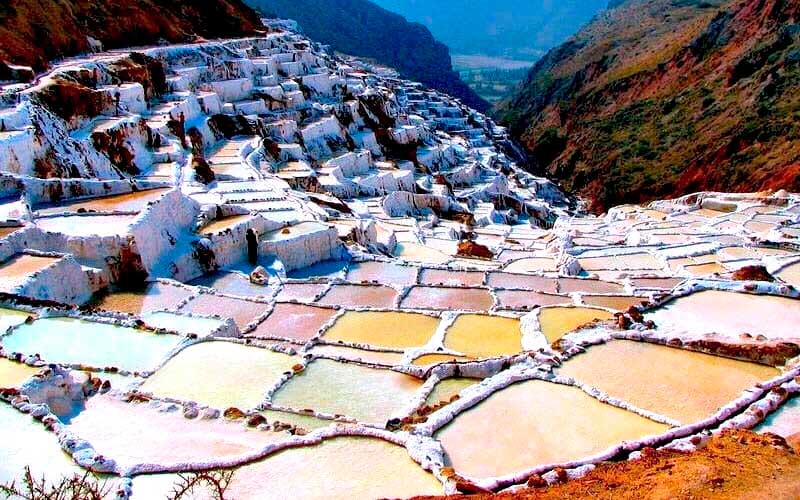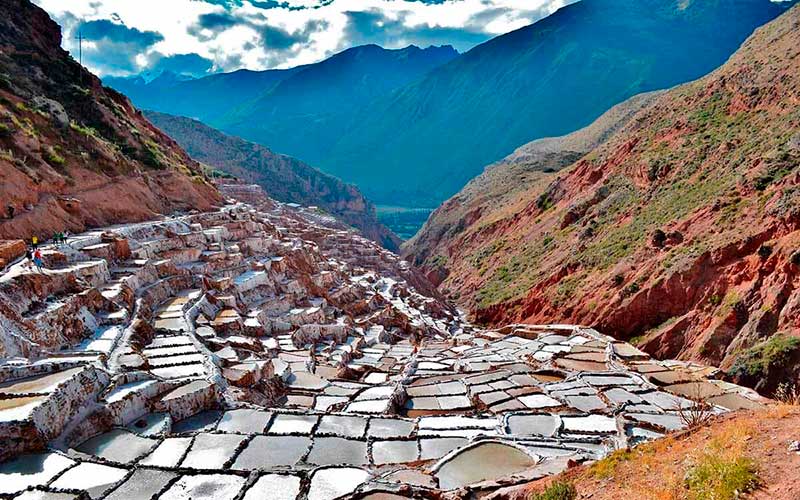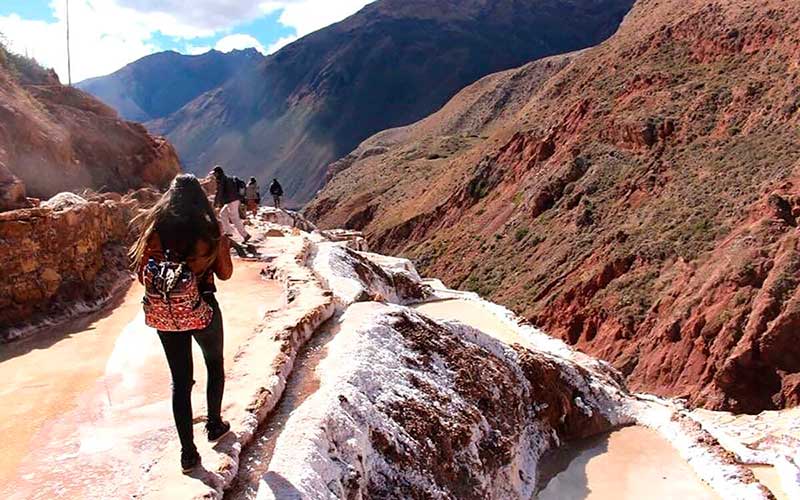Travel guide: Salt mines of Maras
The Sacred Valley of the Incas is a territory full of incredible landscapes and unique archeological sites. One of the most visited are the famous Salineras de Maras. This attraction is made up of thousands of small pools carved into the mountainside. These salt wells have been captured by photography lovers from around the world.
- Maras salt mines: basic information
- Maras salt mines: price, tours and more
- Frequently asked questions about the Salineras de Maras
Maras salt mines: basic information
What are the Salineras de Maras?
- The Salineras de Maras is made up of more than 3 thousand natural salt wells near the town of Maras. Each of the wells has a dimension of 5 square meters.
- The 3,000 pools are fed by an underground hypersaline spring that originated 110 million years ago during the formation of the Andes Mountains.
- Currently, these natural salt pools attract hundreds of tourists. The view you get from this landscape is beautiful.
- The inhabitants of Maras sold this salt, just as the Incas did hundreds of years ago.

Salt mines of Maras
You can visit the Salineras de Maras on your own or with an organized tour. The tour includes a visit to the Inca platforms of Moray. If you travel without a tour you can buy your entrance ticket to Maras at the same entrance door.
Where are the Salineras de Maras?
- The Salineras de Maras are 46 kilometers from the city of Cusco in the Sacred Valley of the Incas.
- Thousands of shallow pools filled with salt water are excavated on the slope of Qaqawiñay Mountain, 3,380 meters from the sea (11,080 ft).
How to get to the Salineras de Maras?
- The salt mines of Maras are 10 kilometers away from the town of Maras.
- From the city of Cusco to the Salineras de Maras there are approximately 50 kilometers away.
- To get to the Salineras de Maras from the city of Cusco you must take a bus to Urubamba and stop at a detour that leads there, after another trip by collective taxi.
- Most tourists choose to reach the Salineras de Maras through a tour organized by a tourism agency. This service includes full transport.
How high are the Salineras de Maras?
- The Maras Salineras in Cusco are located at an altitude of 3,200 meters above sea level (approximately 10,498 feet above sea level).
History of the Maras Salt Mines
- The origins of the Maras Salineras go back thousands of years. From the summits of the Qaqawiñay mountain, salty waters gush out and, when evaporated by the powerful sun, form the natural salt wells characteristic of Maras.
- However, there is also a mythical origin of the Salineras de Maras related to the famous legend of The Ayar Brothers. This tells the story of Ayar Cachi, one of the brothers who, together with Manco Cápac, undertook the journey to found Cusco.
- Ayar Cachi was the strongest of the four brothers, capable of throwing a stone into the mountain and forming a ravine. The other brothers, fearful of Ayar Cachi’s power, through deception, locked him in a cave, walling it up with a stone. Ayar Cachi’s tears of anger formed the multiple pools of saline water, which would later become the Salineras de Maras.
- It is estimated that the Wari culture (from the 7th century AD to the 13th century AD) was the first civilization that organized the exploitation of salt wells during their occupation in the Cusco valley. Then, the Incas (13th century AD to 16th century AD) organized the production and distribution of Maras salt, which was even used in religious ceremonies for the embalming of mummies.
- Today the Maras Salineras are worked by the residents of the town of Maras and the local peasant communities. Each family has a certain number of posas, which are worked and distributed in the different markets of Cusco. Ownership of the salt pools is inherited from generation to generation.
Map of the Salineras de Maras
- The Salineras de Maras are 26 kilometers away by car from the town of Chinchero.
- The Salineras de Maras are 16 kilometers away by car from the town of Urubamba.
What to do in the Salineras de Maras?
- In the Salineras de Maras you can buy ‘natural salt pink’. This gets its beautiful color from the natural elements of the spring water including: magnesium, calcium, potassium and silicon.
- Another interesting thing about the Salineras de Maras is that you can pick up your own handful of salt or buy a jar at the Maras gift shop.
- You can also take amazing photos of the salt mines, one of the most incredible places in Cusco and Peru.
- Just 10 kilometers from the Salineras de Maras is the archaeological complex of Moray , another of the most incredible tourist attractions of the Sacred Valley.
- Maras has a colonial town famous for its traditional adobe houses and its typical traditions and festivals.
Maras salt mines: price, tours and more
How to visit the Salineras de Maras?
- You can enter the Salineras de Maras paying 7 Peruvian soles (2.5 USD). The site does not need any tickets like many other archeological sites in Cusco.
- Please note that in Maras you will not be able to pay with your credit card, US dollars, euros or any other currency.
- Another option is to buy a tour to Maras, which includes the visit to the archaeological site of Moray.

People working in Las Salinas
What to bring to the Salineras de Maras?
During your visit to the Salineras de Maras do not forget to bring the following:
- Raincoat
- Hat or cap.
- Sunscreen.
- Sunglasses.
- Sportswear.
- Anti-slip shoes.
- Photographic camera.
- Documents
- Snacks
- Cash.
Maras salt is formed after a process of filling salty (hot) water from the subsoil. The spring is blocked for a few days, the intense sun causes the water to evaporate leaving crystals of pure salt that is then collected in sacks.
How much does it cost to visit the Salineras de Maras?
- The entrance ticket to the Salineras de Maras costs 10 Peruvian soles.
- It should be noted that entry to the Maras Salineras is not included in the Cusco Tourist Ticket. This ticket includes a visit to other tourist sites in Cusco, such as: Moray, Chinchero, Ollantaytambo and more.
- Another way to visit the Maras Salineras in Cusco is through an all-inclusive tour. The most popular services are: a) the Maras – Moray half-day Tour (60 USD), b) Maras – Moray quad bike half-day Tour (66 USD) and c) VIP Sacred Valley Tour, which includes Maras, Moray, Chinchero, Ollantaytambo and Pisac (80 USD).
Salineras de Maras: visit with tour or on your own
Because there are no direct buses to the Salineras de Maras, traveling on your own can be somewhat expensive. Don’t know whether to visit Maras with a tour or on your own? These are the differences between both experiences:
| With all-inclusive tour (Maras – Moray half day) | On your own | |
| Starting point | Tourist hotel door in Cusco | Public transport bus stop on Belenpampa street |
| Transport | Full tourist transportation included | Transfer in collective taxis to Maras (40 USD round trip). |
| Entrance | Entrance ticket to Maras and Moray included in the tour | Entrance to Salineras de Maras (3 USD). |
| Tour guide | Included in the tour (group tour guide) | Optional service for 15 USD. |
| Feeding | Not included in the tour | Optional |
| Total cost | 60 USD | 58 USD |
Recommendations to visit the Salineras de Maras
- Most people who come to Cusco to visit Machu Picchu, take time to meet and take some photos of the Salineras de Maras.
- Take advantage of your visit to the Salineras de Maras to know the Inca platforms of Moray, one of the busiest tourist attractions in the Sacred Valley.
- If you choose to visit Maras with an organized tour, dare to do an ATV adventure through Maras and Moray. This is one of the favorite tours for tourists looking for some adventure in the Sacred Valley.
- After visiting the Salineras de Maras you can take advantage of knowing the famous town of Urubamba, in the heart of the Sacred Valley .
Maras and Moray: comparison
hese are some differences and similarities between the Salineras de Maras and the circular platforms of Moray in Cusco.
| Maras salt mines | Inca platforms of Moray | |
| Location | 49 kilometers from the city of Cusco (in the province of Urubamba – Sacred Valley of the Incas). | 54 kilometers from the city of Cusco (in the province of Urubamba – Sacred Valley of the Incas). |
| Height | 3,200 meters above sea level. | 3,500 meters above sea level. |
| Function | Production and collection of salt for Cusco since before Inca times. | Agricultural laboratory for the production of potatoes, corn, olluco, maca, pumpkin and more. |
| Construction | First wells made by the Wari culture (from the 7th century AD to the 13th century AD). | First constructions made by the Ayarmaca culture (13th century). |
| Landscape | Beautiful natural landscape with views of hundreds of salt wells. | Beautiful natural landscape with views of circular platforms similar to amphitheatres. |
| Entry price | General admission: 10 Peruvian soles | Cusco Tourist Ticket: 70 foreign soles / 40 Peruvian soles. (includes Moray, Pisac, Ollantaytambo and Chinchero). |
| Circuit | Short circuit of 2 viewpoints (approximately 30 minutes). | Short or long circuit with several viewpoints (approximately 45 minutes). |
| Climate | Temperate climate with temperatures from 0ºC. up to 21ºC. | Temperate climate with temperatures from 0ºC. up to 21ºC. |
| Tours | Included in the tours: a) Maras – Moray half day, b) Maras – Moray on ATV half day or c) Sacred Valley VIP (includes Maras, Moray, Pisac, Ollantaytambo and Chinchero). | Included in the tours: a) Maras – Moray half day, b) Maras – Moray on ATV half day or c) Sacred Valley VIP (includes Maras, Moray, Pisac, Ollantaytambo and Chinchero). |
Frequently asked questions about the Salineras de Maras
1) Where is Maras?
The Salineras de Maras are 46 kilometers from the city of Cusco in the Sacred Valley of the Incas. It belongs to the district of Maras, province of Urubamba in the department of Cusco.
2) How old are the Maras salt mines?
The Maras salt mines have a natural origin dating back 110 million years.
3) How to go from Cusco to the Salineras de Maras by public transport?
The trip from Cusco to the Salineras de Maras by public transport is complicated. First, you must take a bus on Belenpampa street to the Maras detour. Then you must take a collective taxi to the town of Maras. Finally, you must take another collective taxi to the Salineras.
4) How much does it cost to enter the Maras salt mines?
The entrance to the Salineras de Maras costs 10 Peruvian soles for all tourists.
5) Can I enter the Maras salt wells?
No, currently the entrance to the salt wells of Maras is prohibited.
6) How many salt wells does Maras have?
The Maras salt mines are made up of more than 3,000 salt wells distributed among approximately 400 families.
7) Where to buy Maras salt?
Maras salt can be purchased at the site museum at the Maras salt mines. You can also buy in the main markets of Cusco such as the San Pedro market.
8) How much does a tour to the Maras salt mines cost?
The tour to the salt mines of Maras includes a visit to the circular platforms of Moray and the town of Maras. The service lasts half a day (5 hours) and costs approximately 45 dollars per person.
9) What else to see near Maras?
Just 7 kilometers from the salt mines of Maras, you can visit the circular platforms of Moray, one of the best tourist attractions in the Sacred Valley of the Incas.
10) What is the weather like in the salt mines of Maras?
The climate in the salt mines of Maras is temperate with temperatures that vary from a maximum of 22ºC. up to a minimum of 2ºC. The winds are strong so it is recommended to wear a windbreaker jacket during the visit.
Advice from people who have been there
 By: Jenny L
By: Jenny L“A unique place“
“The pink salt is extracted only from 4 places in the world and one is Maras, the more than 3,000 wells are worked by the families of the town. I saw large families who extracted salt from up to 10 wells at a time, they collect and sell their product, but you can also pick up your own salt.“
By Ticket Machu Picchu – Last updated, August 15, 2024










